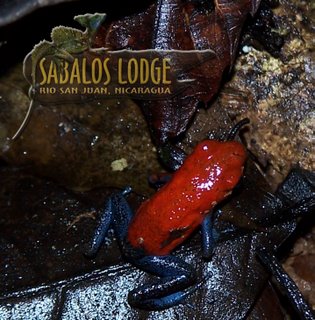

October 4, 2006
One good thing about an 8:30 bedtime is that it makes it easier to get up at 5:30. We met our tour guide at the docks at 6 a.m. and set off for the Indo-Maiz Reserve, a 43,000 hectare swath of tropical humid forest, spread out from 8 kilometers east of El Castillo all the way to the Caribbean.
We motored slowly through the rapids and downriver, the forest growing ever more dense as we traveled. We moved slowly over the glass-smooth water, the mist sometimes so thick we could barely see ahead. Egret, heron and the black anhinga flapped their wings upon our approach. The jungle – thick, dark, impenetrable – stood shrouded in the misty smoke.
Our tour included the rental of knee-high mud boots, which we needed for the muddy trail. We got off at a small dock on the edge of the reserve and waked up to the park ranger’s house to sign in. A many walked out, next to a large, tabby cat.
The cat walked with strong steps and looked at us with a menacing gaze. As soon as I commented on the strange cat, it began to hiss and head toward us. Turns out it was a baby ocelet. It approached each of us individually, hissing, and reached its paws around Mark’s leg. The ranger had a domestic cat as well, who didn’t seem too please with its new wild feline neighbor.
We entered the darkness and magic of secondary forest within minutes, following a muddy, but well-maintained two kilometer trail through the forest. An opaque stream ran through a green fantasy world of trees, flowers, vines, ferns birds, insects and animals. The sounds of the jungle inhabitants rang out around us, the coo of the paloma, the ribbet of the poisonous blue jeans dart frog, the fingernails over a washboard sound of the cigarra, whose singing increased in strength as the sun rose.
Walking through this world, I felt as though I were gliding through a secret world. It seemed the environment was ready to pull us down, eat us, make us succumb to natural forces and become a part of it.
We spotted the blue jean dart frog, a bright red miniature frog with a dark blue behind It’s so poisonous that just by touching it, the poison can seep in through a cut or wound. The native peoples used these frogs to poison their spears. We came across a small, poisonous vibora snakes, lodged in the corner of a step. Best of all, we saw lots of white-faced monkeys (called cappuccino monkeys), with white furry faces and brown behinds. They looked at us menacingly from the tree boughs and approached us in an attempt to intimidate us. But they never left their high perches.
We also saw some of the bounteous plant life lodged in the jungle – the 300 year old mountain almendro, that both feeds the great green macaw with its fruit and produces an oil that the bird uses to comb its wings. The ceiba, worshipped by the Indians for purifying the land. The site of bloody rituals to help its further growth and purification. The moving leaves, carried by the leaf-cutting ant, the only insect that can carry 2-3 times its weight.
During a short boat ride down the River Bartola, the water that separates the reserve from non-reserve land, we watched turtles sunning themselves on logs, herons standing delicately at the water’s edge, chocolate spider monkeys crossing the river via tree boughs, and balete fish, with piranha-like teeth, used for eating fruit seeds that fall into the river, jumping up from the water.
After a lunch of large river shrimps in garlic, we took the public boat back upstream to Sabalos Lodge. It is a series of cabanas on the riverbank, two kilometers away from Sabalos.
We are staying in the Tarzan cabana, a t-frame thatch hut located on the riverbank. We arrived to the sound of howler monkeys and entered a world of hummingbirds, salamanders, caimans and another assortment of forest life. On the upper level of our hut, we have a bedroom, bathroom and a balcony with a bench that look out right over the water. Downstairs, we have a pair of hammocks, where we can rock from side to side while taking in a bird’s eye view of the river and the green forested shore beyond.
The friendly local owner, a former Sandinistan general, treated us to juice made with small oranges upon our arrival, and later to sangria made from grapefruit, orange, lemon and jackfruit grown on his own farm.
Again, sleep with come early tonight. With no multimedia and light attracting bugs, it makes more sense to go to bed early and rise at dawn for a new set of activities.
I’ll walk back to our hut along a path lit by lemon-scented torches, listening to the music of cicadas and the croaking of frogs.
**the photos are of the blue jean dart frog, a caiman, and our riverside Tarzan cabana (which, by the way, is where Mark proposed)




No comments:
Post a Comment